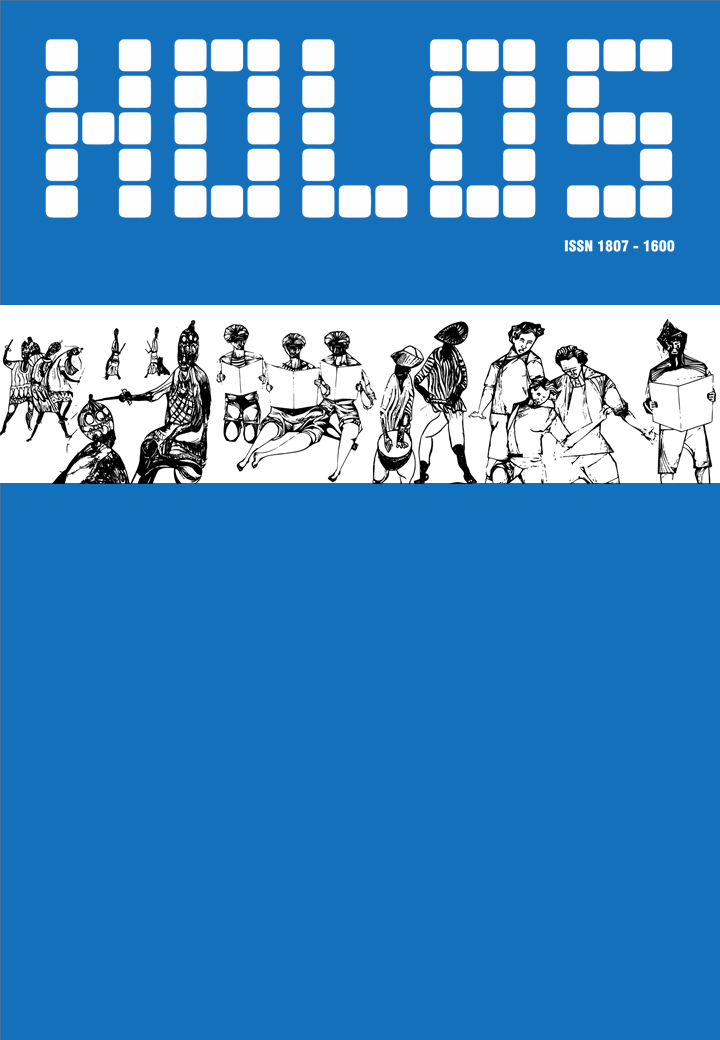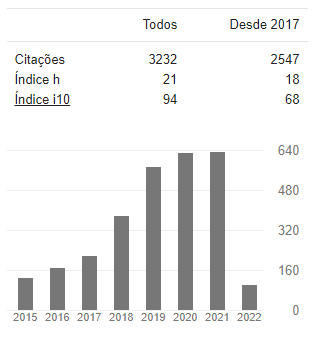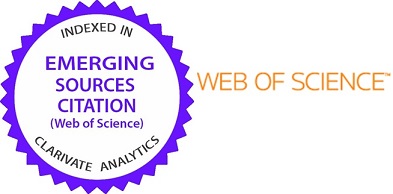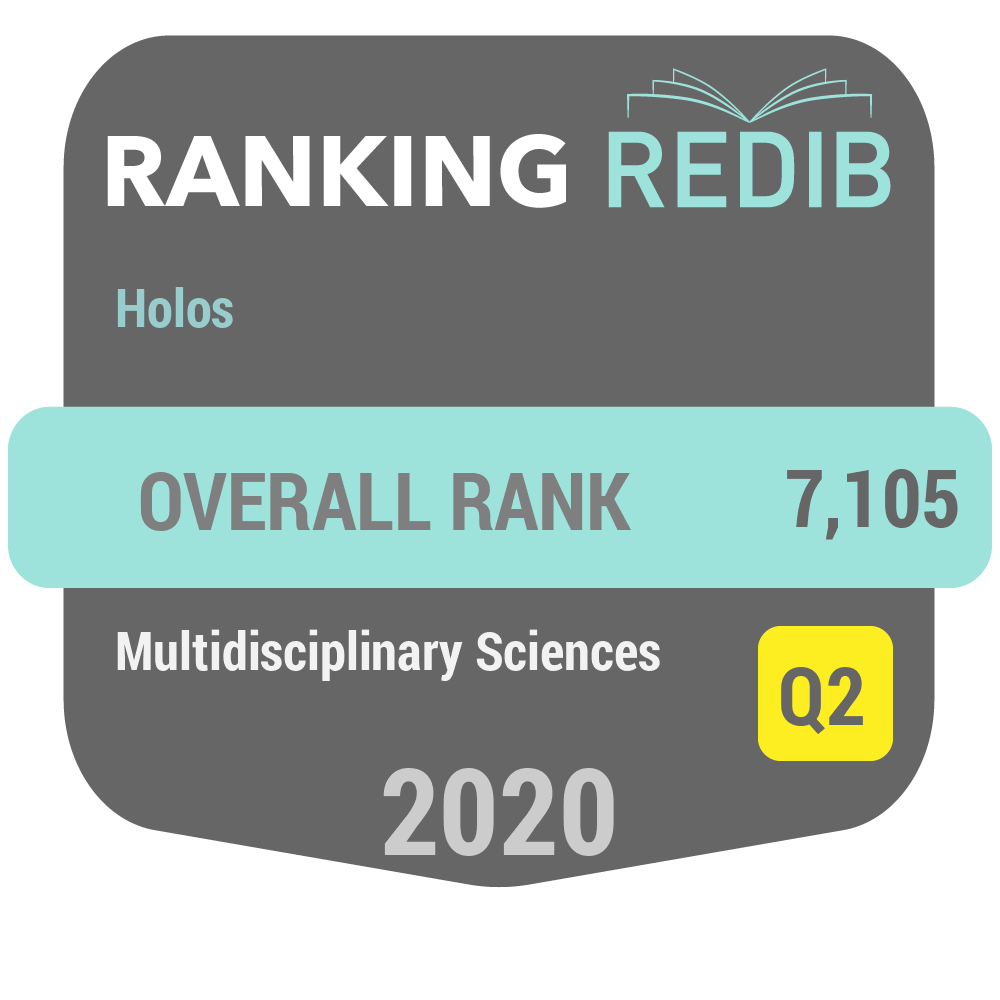TRANSFORMATIVE SERVICE RESEARCH E O BEM-ESTAR EM ESPAÇOS COLETIVOS URBANOS
DOI:
https://doi.org/10.15628/holos.2021.11195Palavras-chave:
Transformative service research, Bem-estar, espaços coletivos urbanos.Resumo
As transformações ocasionadas pelos serviços podem levar o indivíduo a aumentar seu bem-estar (BLOCKER; BARRIOS, 2015). Os espaços públicos urbanos promovem a socialização e um padrão de comportamentos transformadores a partir de seu uso (TUAN, 1993). Dessa forma, a relação entre serviços e bem-estar neste estudo se dá tomando por serviço o usufruto das áreas coletivas urbanas, as praças, e tendo resultado a transformação manifestada pelo bem-estar do indivíduo que frequenta a praça, cuja função social é promover a qualidade de vida e bem-estar para a população (MARQUES et al., 2014). Nesta pesquisa, optou-se pela abordagem qualitativa, utilizando-se a entrevista semiestruturada como método de coleta de dados, que serão analisados por análise de conteúdo. A análise dos dados coletados foi feita em vista do cumprimento dos objetivos específicos da pesquisa. A pesquisa revelou que as praças geram valor e bem-estar aos visitantes a partir da qualidade da experiência que proporcionam. Sugere-se o aprofundamento estatístico destes resultados por meio de um survey, para verificar especificamente quais atributos das praças tem mais influência sobre o bem-estar ou a transformação dos indivíduos, Sugere-se, também, o estudo da solidão voluntária em praças e como esta experiência pode influenciar positivamente o bem-estar dos visitantes.
Agradeço ao CNPq pelo apoio financeiro ao projeto.
Downloads
Referências
ANDERSON, L. et. al. (2013). Transformative service research: an agenda for the future. Journal of Business Research,v. 66, n. 8, p. 1203–1210. DOI: https://doi.org/10.1016/j.jbusres.2012.08.013
ANDERSON, L.; OSTROM, A.L.; BITNER, M.J. (2011). Surrounded by services: a new lens for examining the influence of services as social structures on well-being,working paper, W. P. Carey School of Business, Arizona State University.
ANDREASEN, A. R.; GOLDBERG, M. E.; SIRGY, J. (2012). Foundational research on consumer welfare: Opportunities for a Transformative Consumer Research Agenda. In: MICK, D.; PETTIGREW, S.; PECHMANN, C.; OZANNE, J. (Ed.). Transformative consumer research for personal and collective well being: reviews and frontiers.Taylor & Francis, p. 25-65.
BLOCKER, C.P.; BARRIOS, A. (2015). The transformative value of a service experience. Journal of Service Research,Vol. 18 No. 3, pp. 265-283. DOI: https://doi.org/10.1177/1094670515583064
BOSANGIT, C.; HIBBERT, S.; MCCABE, S. (2015) “If I was going to die I should at least be having fun ”: Travel blogs , meaning and tourist experience. Annals of Tourism Research,v. 55, p. 1–14. DOI: https://doi.org/10.1016/j.annals.2015.08.001
BRAGG, R. et al. (2014) Wellbeing benefits from natural environments rich in wildlife: a literature review for the wildlife trusts.London: [s.n.].
BRENNAN, L.; PREVITE, J.; FRY, M.L. (2016). Social marketing’s consumer myopia. Journal of Social Marketing,v. 6 n. 3, p. 219-239. DOI: https://doi.org/10.1108/JSOCM-12-2015-0079
CUNHA, M. L. O. da; MAZO, J. Z. (2015). The diffusion of corporal practices in the public squares of city of porto alegre (1920-1940). Rev. educ. fis. UEM, Maringá, v. 26, n. 1, p. 79-87. DOI: https://doi.org/10.4025/reveducfis.v26i1.21873
DAVIS, B.; OZANNE, J. L.; HILL, R. P. (2016). The Transformative Consumer Research Movement. Journal of Public Policy & Marketing. DOI: https://doi.org/10.1509/jppm.16.063
DINARDI, A. J.; FEIFFER, A. H. S.; FELIPPELLI, H. E. (2018). O uso de praças públicas como espaço não formal de educação. Revista Educação, Cultura e Sociedade, v. 8, n. 1, p. 311-326.
DOS SANTOS, K. P., & de Oliveira, V. D. P. S. (2020). PERCEPÇÃO AMBIENTAL DAS COMUNIDADES AO ENTORNO DO PARQUE ESTADUAL DA LAGOA DO AÇU/RJ. HOLOS, 6, 1-16. DOI: https://doi.org/10.15628/holos.2020.2942
EDGAR, F. et al. (2017). A transformative service research agenda: a study of workers’ well-being, The Service Industries Journal, v. 37, n. 1, p. 84-104. DOI: 10.1080/02642069.2017.1290797 DOI: https://doi.org/10.1080/02642069.2017.1290797
EDGINTON, C. R.; CHEN, P.(2002). Leisure as transformation.Sagamore Publishing, 2014. IRVINE, K.N.; WARBER S. L.. Greening healthcare: practicing as if the natural environment really mattered. Altern Ther Health Med,v. 8, n. 5, p. 76-83.
KARDAN, O. et al. (2015). Neighborhood greenspace and health in a large urban center. Scientific Reports. DOI: 10.1038/srep11610 DOI: https://doi.org/10.1038/srep11610
KOTLER, P. (1998). The market for transformation. Journal of Marketing Management,v. 35 n. 5-6, p. 407-409, 2019. KOTLER, P. Administração de marketing: análise, planejamento, implementação e controle.São Paulo: Atlas. DOI: https://doi.org/10.1080/0267257X.2019.1585713
KUHNEN, A.; LUZ, G. M. (2016). Use of urban spaces by children: exploring the behavior of playing in public squares. Psicologia: Reflexão & Crítica,v. 26, n. 3, 2013. KUPPELWIESER, V. G.; FINSTERWALDER, J. Transformative service research and service dominant logic: Quo Vaditis? Journal of Retailing and Consumer Services,v. 28, p. 91–98. DOI: https://doi.org/10.1016/j.jretconser.2015.08.011
LARSON, L. R.; JENNINGS, V.; CLOUTIER, S.A. (2016). Public Parks and Wellbeing in Urban Areas of the United States. PLoS ONEv. 11, n. 4. DOI: https://doi.org/10.1371/journal.pone.0153211
LEMON, K. A. (2014). Multidisciplinary perspective on service wellbeing. Journal of Service Research Special Issue on Transformative Service Research.v. 18, n. 3; p. 243-249, 2013. MARQUES V. R. et. al. Uso de áreas verdes em Mogi Mirim: preferência da população. Revista da Sociedade Brasileira de Arborização Urbana,p. 46 -59.
MCCABE, S.; JOHNSON, S. (2013). The Happiness Factor in Tourism: Subjective Well-Being and Social Tourism. Annals of Tourism Research, v. 41. p. 42–65. DOI: 10.1016/j.annals.2012.12.001. DOI: https://doi.org/10.1016/j.annals.2012.12.001
MEDBERG, G.; GRÖNROOS, C. (2020). Value-in-use and service quality: do customers see a difference? Journal of Service Theory and Practice. DOI: https://doi.org/10.1108/JSTP-09-2019-0207
MICK, D. G. et. al. (2012). Origins, qualities, and envisionments of transformative consumer research. In: MICK, D..; PETTIGREW, S.; PECHMANN, C.; OZANNE, J. (Eds.). Transformative Consumer Research for personal and collective well being: Reviews and Frontiers.Boca Raton, FL: Routledge. Taylor & Francis, p.3-24. DOI: https://doi.org/10.4324/9780203813256
OLIVEIRA, J.P., de Freitas, I. N., & de Mendonça Nóbrega, W. R. (2018). Participação comunitária no desenvolvimento do turismo: um estudo no Parque Estadual da Pedra da Boca-PB. HOLOS, 6, 151-170. DOI: https://doi.org/10.15628/holos.2018.6971
OSTROM, A.L., et. al. (2010). Moving forward and making a difference: research priorities for the science of service.Journal Service Research,v. 13,n.1, p. 4–36. DOI: https://doi.org/10.1177/1094670509357611
PAN, T.-J. (2014). Personal Transformation Through Volunteer Tourism: The Evidence of Asian Students.Journal of Hospitality & Tourism Research,v. 41, n. 5, p. 1–26. DOI: https://doi.org/10.1177/1096348014538048
PENG, Y; FENG, T.; TIMMERMANS, H. J. P. (2019). Expanded comfort assessment in outdoor urban public spaces using Box-Cox transformation. Landscape and Urban Planning,v. 190. DOI: https://doi.org/10.1016/j.landurbplan.2019.103594
PINE, J.; GILMORE, J. H. Welcome to the Experience Economy. Harvard Business Review,p. 97-105, 1998.
PLÉ, L.; CHUMPITAZ, C.R. (2010). Not always Co-creation: introducing interactional co-destruction of value in service-dominant logic. Journal of Services Marketing,v. 24, n. 6, p. 430–37. DOI: https://doi.org/10.1108/08876041011072546
PRETTY, J.; BARTON, J.; SELLENS, M.; GRIFFIN, M.(2005). The mental and physical health outcomes of green exercise. International journal of environmental health research.v. 15, p. 319-37. DOI: 10.1080/09603120500155963. DOI: https://doi.org/10.1080/09603120500155963
RAPP, J. M. et al. (2015). Consumer transformation through volunteer service experiences. The Service Industries Journal, v. 35, n. 15-16, p. 865-882. DOI: 10.1080/02642069.2015.1090981 DOI: https://doi.org/10.1080/02642069.2015.1090981
SAMPAIO, S. (2014). Tourism and transformation: negotiating metaphors, experiencing change. Journal of Tourism and Cultural Change, 12:2, 93-101. DOI: 10.1080/14766825.2014.924674 DOI: https://doi.org/10.1080/14766825.2014.924674
SANTANA, V. S; GONDIM, S. M. G. (2016). Emotion regulation, psychological well-being and subjective well-being. Estudos de psicologia (Natal),Natal, v. 21, n. 1, p. 58-68.
SCHNEIDER, I.; WILHELM, S.; HEISEY, J. (2005). Carlyle Lake visitor profile: experiences, benefits and opportunities. Staff Paper Series 177.St. Paul: Department of Forest Resources, University of Minnesota.
SHANAHAN, D. et al. (2016). Health Benefits from Nature Experiences Depend on Dose. Sci Rep 6, 28551. DOI: 10.1038/srep28551 DOI: https://doi.org/10.1038/srep28551
SHUVO, F. K. et al.ell-Burt, Thomas. Urban green space and health in low and middle-income countries: a critical review. Urban Forestry & Urban Greening,2020. DOI: 10.1016/j.ufug.2020.126662. DOI: https://doi.org/10.1016/j.ufug.2020.126662
SUNDQUIST, K.; FRANK, G.; SUNDQUIST, J. (2004). Urbanisation and incidence of psychosis and depression: Follow-up study of 4.4 million women and men in Sweden. The British Journal of Psychiatry,v. 184, p. 293–298. DOI: https://doi.org/10.1192/bjp.184.4.293
TAYLOR, L.; HOCHULI, D. (2015) Creating better cities: how biodiversity and ecosystem functioning enhance urban residents’ wellbeing. Urban Ecosystems, v. 18. p. 1-16. DOI: 10.1007/s11252-014-0427-3. DOI: https://doi.org/10.1007/s11252-014-0427-3
TUAN, Y. (1993). Espaço e Lugar: a perspectiva da experiência. Trad. Lívia de Oliveira. São Paulo: Difel.
VARGO, S. L.; LUSCH, R. F. (2016). Institutions and Axioms: An Extension and Update of Service-Dominant Logic. Journal of the Academy of Marketing Science, v. 44, n. 1, p. 5–23. DOI: https://doi.org/10.1007/s11747-015-0456-3
WASSALL, A. R. A. & SALLES, M. Do R. R. (2019). Cidades e praças: ambivalência da hospitalidade em espaços públicos. Rosa dos Ventos - Turismo e Hospitalidade,v. 11, n. 2, p. 386-399. DOI: https://doi.org/10.18226/21789061.v11i2p386
WILKIE, W. L. ; MOORE, E. S. (2012). Expanding our understanding of marketing in society. Journal of the Academy of Marketing Science,Seattle, WA, v. 40, n. 1, p. 53-73. DOI: https://doi.org/10.1007/s11747-011-0277-y
WOYCIEKOSKI, C.; STENERT, F.; HUTZ, C. S. (2012). Determinantes do Bem-Estar Subjetivo. PSICO,Porto Alegre, PUCRS, v. 43, n. 3, pp. 280-288.
YE, H.; TUSSYADIAH, I. P. (2016). Tourists' Transformation Experience: From Destination Architecture to Identity Formation. Travel and Tourism Research Association: Advancing Tourism Research Globally,v. 20.
ZANON, C.; HUTZ, C. S. (2010). Thinking styles, personality and subjective well-being: advances and polemics. Aletheia, Canoas, n. 32, p. 80-91.
ZEITHAML, V. (1988). Consumer perceptions of price, quality and value: a means-end model and synthesis of evidence.Journal of Marketing,New York, v. 52, n.3, p. 2-22. DOI: https://doi.org/10.1177/002224298805200302









































